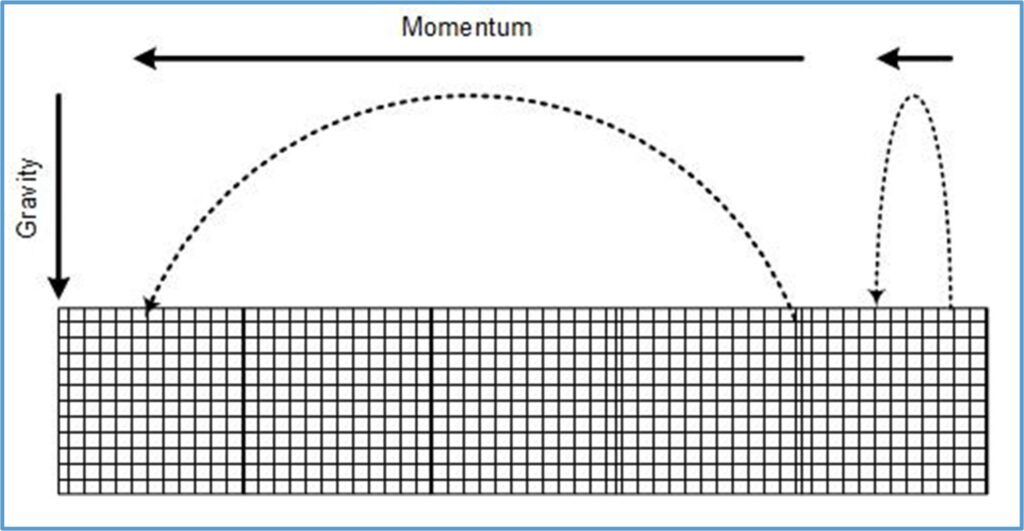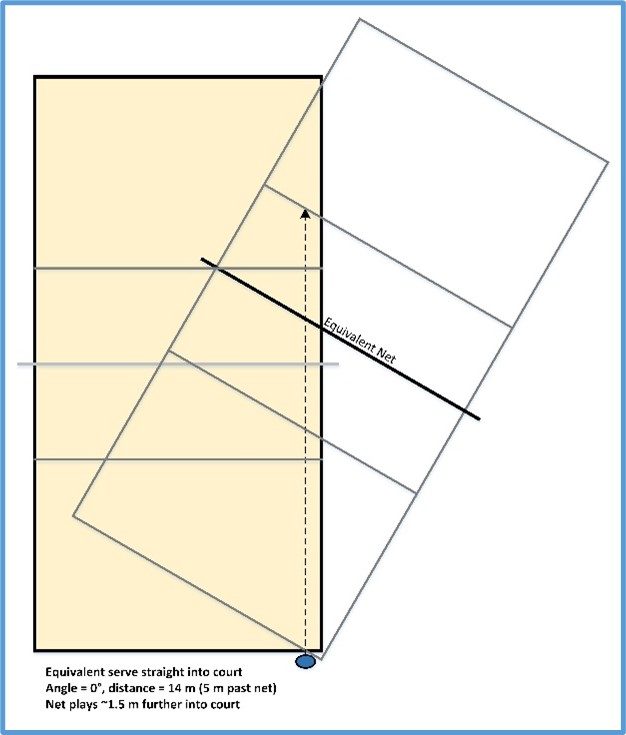
It can often be useful to explain volleyball skills to players mathematically, especially when visual aids can be used, in an effort to make them the concepts
easier to explain and understand. In addition, it helps tie together topics players may have learned in the classroom, offering real-life examples of how their
educational training in the classroom applies to physical training they receive on the court.
Coaching juniors and college club (NCVF) teams, I have players from youth to adult that deal with some of the same concepts. Even though my older players may excel at the skills from rote learning and competitive experience, they may not know the fundamental reasoning behind techniques which would allow them to adapt to different situations and, hopefully, coach others someday.
Tempo vs Distance
One situation occurs frequently when working with players to speed up our offense by using second and third tempo outside sets. The outside hitters frequently have the misconception that the farther a ball is set along the net, the longer it takes the ball to get there. The diagram below shows two sets of the same tempo, one close to the setter for a middle attack and one to the outside hitter.

Although the outside set travels farther horizontally, only the height of the set affects the timing of an outside’s approach. The horizontal speed has no effect on timing although the distance does affect the direction of approach. The time it takes the ball to rise and fall to the ideal height for the hitter’s attack is determined strictly by gravity. So the first step of an outside hitter’s approach must account for the set release point (height of the setter’s hands) and how high ball goes, no matter how close or the ball goes from the setter. That’s why if the setter jumps or crouches, it affects the timing. Since some of my players are science and engineering students and it is amusing to see that “ah ha” moment when they realize they studied this in their first physics class and have successfully passed innumerable exercises and quizzes about it.
Even players with many years of success attacking these sets may not understand this concept, such as rote learners who learn solely from repetition. This can lead to mistakes when they are in unfamiliar situations such as out of system plays with the setter on the run or when working on new plays in practice with same tempo sets going to different locations.
A similar timing issue occurs for middle hitters when running quicks. If the pass to the setter is higher or lower than ideal, it affects their timing. For example,
if a hitter’s cue for starting her approach is the ball passing over her, a higher pass will require the middle to start later and a low pass will require the middle to
approach sooner. The distance of the passer has no effect on the timing, so it doesn’t matter if the passer is inside the attack line or on the end line – only the height of the pass matters.
Optical Illusion
Human beings tend to think with their eyes, which makes them subject to visual misconceptions. An example of this is the short cross-court serve. It’s
visually deceiving for the server which often leads to serves going into the net or out of bounds. In competition, I usually avoid calling for this serve, even if it would be advantageous tactically, unless I’m intentionally giving a player practice for it in competition or the server has already proven to be competent using it.
The serve itself isn’t that much more difficult than other serves if the server understands the geometry of the court. Because the serve must travel at an angle, assuming a straight serve is zero degrees, the net is farther from the server and the sideline comes into play. The diagram shows how a short cross court serve would appear if it were served straight into the court.

Serving short cross court to the attack line (10’ past the net) is equivalent to serving straight ahead half-way into the court, with the ball landing 15’ past the net. Also, the net is effectively 5’ farther away from the server than when serving straight so the serve must stay higher farther than a normal short serve.
A related issue is how the sideline comes into play for cross court serves. Essentially, the endline and sideline “fall away” faster than a straight ahead serve depending on the server’s accuracy and normal distribution (error to the side and long). Another visual aid would be to diagram a server’s area of distribution of serves that can be approximated as an isosceles trapezoid aligned to the direction of the serve. This can show how as the angle of serve changes, the probability of serving out increases.
Parabolas
This next example has elements of both of the previous ones – a geometric explanation and a visual misconception. Going back to the faster tempo outside sets, an outside hitter must determine her contact point with the ball in order to approach at the correct angle and make her plant in an optimal location. This means the player must determine parabolic path of the ball to determine a rough angle of approach and then account for the intersection of her arm swing with the path of the ball for the final location.
I’ve found that players often have a visual misconception of where that contact point. Young players are usually trained to hit high sets and direct their approach to where the path of the ball intersects the net. Since high sets drop nearly perpendicular to the net, players learn to use the ball to net intersection as a visual cue of where to make their approaches. However, when sets are faster, the flatter arc of the ball makes the contact point further inside than where the ball would intersect the net. Also, it requires players with higher verticals to approach even farther in for their contact point than where the path of the ball would intersect the net. This causes players to approach too far left, forcing hitters to swing low and hit right.
Conclusion
Understanding the physics and geometry behind the game can increase a player’s (and coach’s) understanding of the skills being learned. It is also beneficial to relate lessons from the classroom, such as physics and mathematics, to sports skills. The diagrams are useful for presenting these concepts to players who prefer visual or logical learning styles. With my older players, I hope these examples will not only inspire them to continue exploring and learning the game but maybe consider coaching as well.
